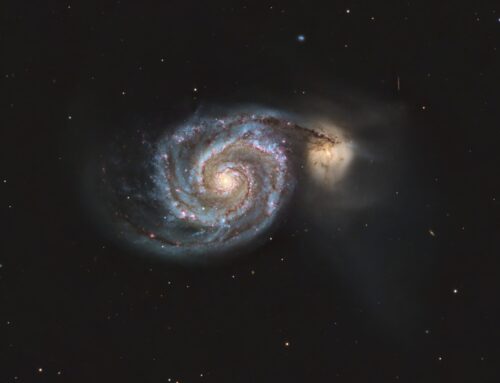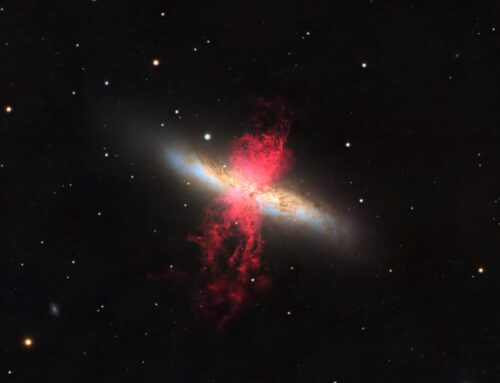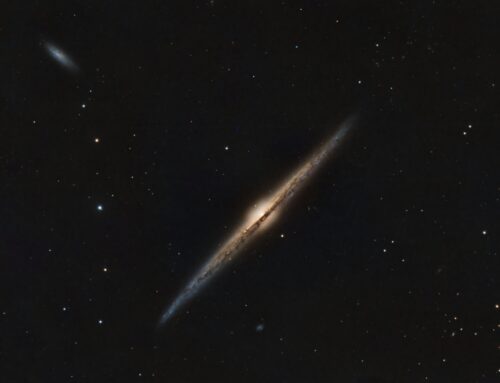NGC4216 and Friends

Click image for full size version
April 16, 2016
The three most prominent galaxies in this image are NGC4216 (centre), NGC4222 (lower left) and NGC4206 (upper right). All belong to the Virgo galaxy cluster. NGC4216 is not far from the centre of this large galaxy cluster, and lied about 55 million light years distant. It sports around 700 globular clusters, about 5 times as many as the Milky Way galaxy. This galaxy shows relatively little star formation for a galaxy of this type. It does show a fair amount of knotty detail and prominent dark lanes. To gain a sense of perspective, remember that all the stars in this image are in the foreground, lying within our own Milky Way galaxy. In addition to the three main galaxies identified above, there are dozens more of all sizes, all part of the same galaxy cluster.
Tekkies:
SBIG STL-11000M camera, Baader LRGB filters, 10″ f/6.8 ASA astrograph, Paramount MX. Guided with QHY5 on a n 80 mm f/6 refractor. FocusMax for focusing. CCD Commander to automate the sessions. Acquistion and guiding with TheSkyX. Al pre-processing and processing in PixInsight. Shot from my SkyShed in Guelph, Ontario. First Quarter Moon. Average to very good transparency and good seeing.
18x10m R and G, and 16x10m B unbinned frames (total=8hr40m).
RGB
Creation and cleanup: R, G and B masters were prepared with ImageIntegration. The R, G and B masters were combined with ChannelCombination, and the resulting RGB image was cropped and processed with DBE, followed by BackgroundNeutralization and ColorCalibration.
Linear Noise Reduction: MultiscaleLinearTransform was used to reduce noise in the background areas of the RGB image. Layer settings for threshold and strength: Layer 1: 3.0, 0.5 Layer 2: 2.0, 0.39 Layer 3: 1.0, 0.25 Layer 4: 0.5, 0.1. A mask was used to protect high signal areas.
Stretching: HistogramTransformation was applied to make a pleasing yet bright RGB image.
Synthetic Luminance
Creation and cleanup: The R, G and B masters were combined using ImageIntegration tool (average, additive with scaling, noise evaluation, iterative K-sigma / biweight midvariance, no pixel rejection) to create the SynthL channel. The image was cropped to match the RGB and DBE was applied.
Deconvolution: A copy of SynthL was stretched to use as a deconvolution mask. A star mask was made from unstretched SynthL to use as a local deringing support. Deconvolution was applied (80 iterations, regularized Richardson-Lucy, external PSF made using DynamicPSF tool with about 25 stars; local deringing at 70% and global dark deringing at 0.01).
Linear Noise Reduction: MultiscaleLinearTransform was applied to reduce the noise. Layer settings for threshold and strength: Layer 1: 3.0, 0.6 Layer 2: 2.0, 0.5 Layer 3: 1.0, 0.4 Layer 4: 0.5, 0.15
Stretching: HistogramTransformation was applied to make an image with similar brightness to the RGB image. TGVDenoise was applied and the image was re-stretched to reset the black point.
Combining SynthL with RGB:
The luminance channel of the RGB image was extracted, processed and then added back into the RGB image as follows:
1. RGBWorkingSpace was applied to the RGB image with all channels equal to 0.33
2. Extract luminance from the RGB image.
3. Apply LinearFit to the extracted luminance using SynthL as the reference.
4. Use ChannelCombination in Lab mode to replace the RGB’s luminance with the fitted luminance from step 3.
5. LRGBCombine was then used to make a SynthLRGB image.
Final Processing
UnsharpMask was applied to the galaxy and mid-sized stars using a mask. Contrast, brightness and saturation were adjusted in several iterations with the Curves tool, with separate adjustments were made for background and stars using a mask.
Image scale is about 1.1 arcsec per pixel for this camera / telescope combination.






Very nice work Ron. Thanks for the detailed explanation of how you put it all together. I am just starting to learn and getting into PixInsight. I am located in Southern CA. My observatory is in in my backyard in Winnetka CA. Named the Winnetka Observatory, housed inside is the Astro-Tech12″ RC. At the moment I am also working on M51 collecting data.
Best regards and Clear Skies.
Geoff